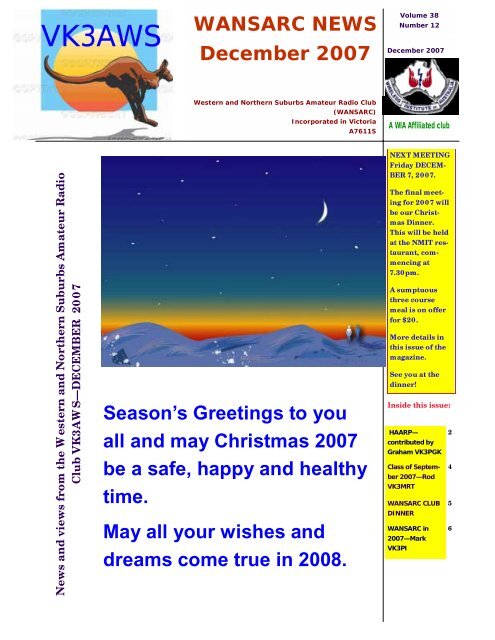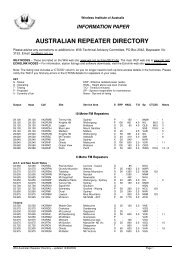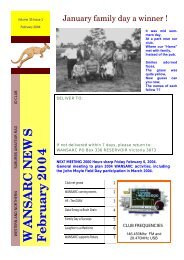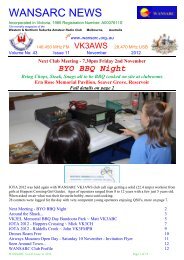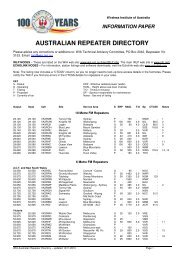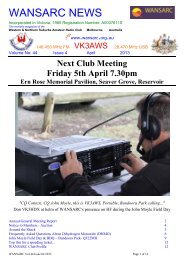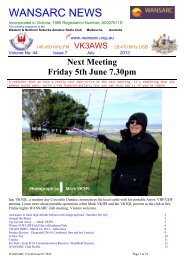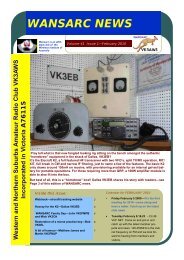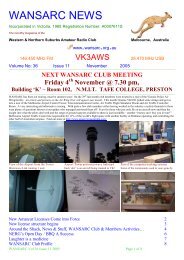VK3AWS - Western & Northern Suburbs Amateur Radio Club
VK3AWS - Western & Northern Suburbs Amateur Radio Club
VK3AWS - Western & Northern Suburbs Amateur Radio Club
Create successful ePaper yourself
Turn your PDF publications into a flip-book with our unique Google optimized e-Paper software.
<strong>VK3AWS</strong>WANSARC NEWSDecember 2007Volume 38Number 12December 2007<strong>Western</strong> and <strong>Northern</strong> <strong>Suburbs</strong> <strong>Amateur</strong> <strong>Radio</strong> <strong>Club</strong>(WANSARC)Incorporated in VictoriaA7611SA WIA Affiliated clubNews and views from the <strong>Western</strong> and <strong>Northern</strong> <strong>Suburbs</strong> <strong>Amateur</strong> <strong>Radio</strong><strong>Club</strong> <strong>VK3AWS</strong>—DECEMBER 2007Season’s Greetings to youall and may Christmas 2007be a safe, happy and healthytime.May all your wishes anddreams come true in 2008.NEXT MEETINGFriday DECEM-BER 7, 2007.The final meetingfor 2007 willbe our ChristmasDinner.This will be heldat the NMIT restaurant,commencingat7.30pm.A sumptuousthree coursemeal is on offerfor $20.More details inthis issue of themagazine.See you at thedinner!Inside this issue:HAARP—contributed byGraham VK3PGKClass of September2007—RodVK3MRTWANSARC CLUBDINNERWANSARC in2007—MarkVK3PI2456
Page 2 WANSARC NEWS December 2007HAARP contributed by Graeme VK3PGKAfter 15 years of effort from multiple contractors and enduringmultiple conspiracy theories alleging it is a “doomsday weapon,”the world’s most advanced high-energy radio physics experimentknow as HAARP (High Frequency Active Auroral Research Program)was declared fully operational in a Wednesday afternoonribbon-cutting ceremony outside the central Alaska hamlet ofGakona.Built upon the site of a cancelled Air Force over-the-horizon radarsite, the massive "instrument" as it is called, comprises 180transmitter towers occupying several acres. The precisely placedand aligned towers dwarf the scrubby black spruce forest andlook like a science fiction movie set piece. These high frequencytransmitters work in close conjunction to precisely “heat” discreteareas of the Earth’s upper atmosphere known as the ionosphere,which is located from about 30 to 500 miles in altitude.HAARP’s focused radio transmissions temporarily increasethe temperature and energy level of the ions and molecules inthe upper atmosphere. This heating can produce spots of manmadeaurora, though they pale in comparison to the power of thenatural aurora and are visible only with sensitive night-visioncameras.HAARP is jointly administered by the U.S. Defence AdvancedResearch Projects Agency (DARPA), the U.S. Air Force ResearchLaboratory (AFRL) and the U.S. Office of Naval Research (ONR)and is run by BAE Systems, the world’s fourth-largest defencecontractor.Adjusting for inflation, approximately $300 million have beenspent on theproject sinceits beginning15 years ago.Currently, annual operations run at about $7.5 million, whichalso funds the salaries of the dozen or so permanent employees.The mix of pure/academic ionospheric and auroral research todefence-related efforts is about 50/50. Each experiment, or campaignas they are called, is funded by whatever school, institutionor defence agency conducting the campaign.In the driver's seat of the HAARP (High Frequency Active AuroralResearch Program) Control Room, Chief Physicist MikeMcCarrick, (above) from BAE Systems, explains how the massive high power ionospheric heater is controlled.The displays above him show how the high frequency radio beam is directed skyward from the array of 180transmitting towers. The beam is rapidly steerable up to 30 degrees from the vertical.Though there are other radio-frequency research heaters located around the world, including the much smallerUniversity of California HIPAS facility near Fairbanks, HAARP is by far the most powerful. HAARP was originallymanaged by ARCO, which was looking for an onsite way to use North Slope natural gas deposits to generate electricityto power the heater. That plan was shelved though HAARP is often confused with an enormous one-milesquare heater designed by Dr. Bernard Eastland that would have used natural gas to power fire HF energy intonear-earth space to create a global blanket of high energy electrons capable of frying any satellite or enemy ballisticmissile flying though it as well as effecting changes to the weather (HAARP is not that machine nor does it emit afraction of Eastland machines energy). HAARP uses five large diesel-powered generators to supply electricity to thetransmitters. The heater has a broadcast power of 3,600 kilowatts, and within the narrow high frequency transmissionband HAARP has an effective radiating power of over 7 gigawatts (billion watts). Housekeeping power isdrawn from the local public grid.
Volume 38 Number 12Page 3While claims of HAARP being an offensive or defensive weapon have largely been discredited,the facility is being used for cutting-edge military-related research. The ionosphere plays a criticalrole in traditional long-range radio communications and HAARP experiments help in forginga deeper understanding of the near-Earth space weather environment that affects defence communications.CHRISTMASWISHESFROM OURMEMBERS TOOUR MEM-BERS……Ben Megans recentlywrote tome and wishesfellow membersthe best forChristmas andthe New Year.Photograph of the HAARP antenna arrayPerhaps the two most important HAARP military efforts involve using the instrument to stimulatethe ionosphere to produce extremely low frequency (ELF) transmissions. ELF, though unableto carry large amounts of data, is able to penetrate to great depths in the ocean and theearth. The U.S. Navy communicates with its nuclear-powered ballistic missile and attack submarinesusing ELF antennae buried in the ground and trailing from airplanes, and it wants to findand new and better ways to reliably produce ELF waves. The other ELF effort is called EarthPenetrating Tomography (EPT). Using HAARP-produced ELF waves, scientists have demonstratedthat they can locate subterranean features and ore bodies -- this technology may prove tobe able to locate underground enemy facilities and installations. Other possible HAARP applicationsmight involve the detection of stealth weapon systems and to deny the communications andearly-warning use of the ionosphere to futureadversaries.The future for HAARP looks busy as its researchschedule is booked up at least throughthe next year. Though the ionosphere-heatinginstrument is complete and operational, researchersare working to obtain funding foradditional diagnostic instruments, including a$50 million dollar incoherent scatter radar,which would help further understand thedeeply complex and intricate nature of theionosphere.DON’T FORGET THE CLUB NET—Tuesday evenings 7.30pm on146.450MHz ably conducted by yourmaestro,Ben and Toniatravelled to QLDin June, returningin September.Ben unfortunatelypicked upa nasty bout ofthe flu and despiteweeks ofmedication it islikely to be another8 weeksbefore Ben iswell again.Thanks for thenote Ben—all thevery best to youand Tonia forChristmas andthe New Year.BOB VK3EL.
Page 4 WANSARC NEWS December 2007Class of September ‘07By Rod Tacey VK3MRT (formerly VK3FRMT)I had been thinking about upgrading from a Foundation to a Standard Licence for some time now.Then, back in August, I received an email from <strong>Amateur</strong> <strong>Radio</strong> Victoria, advising their next BridgingCourse was coming up in September. I decided to enrol in the course and was accepted.Classes commenced at 7pm on Wednesday 5 th September, and the following 3 Wednesday eveningsat <strong>Amateur</strong> <strong>Radio</strong> Victoria’s office in Ashburton. A final class was held at North Box Hill on Saturday29 September, then the exams on Sunday 30 September.Kevin Luxford, VK3DAP, was our course instructor. He made us all feel welcome and his teachingstyle was relaxed yet effective. We went back to basics, covering subjects such as voltage and current– mains and DC, Ohm’s Law, power, capacitance, resistance, inductance and so on. As the coursecontinued, we covered tuned circuits, transmitters and receivers, transmission lines and antennas,propagation, interference, measurements and safety.Left to right, Phil, David Munro VK3VPZ, Graham KochVK3PGK, Ben Fries VK3MBF and Rod Tacey VK3MRTAt times it was heavy going – there wasa lot of material to cover. However,Kevin was always happy to help withany problems and where necessary goover difficult concepts again where required.We were also provided withplenty of study material.There was a great camaraderie amongstmy fellow students – Graeme, Ben,David and Phil. For example, Graemeand I would bounce questions off eachother after class on the way home.On the Saturday Kevin wrapped up thecourse and answered any remaining questions. Sunday morning, prior to the exam, we got togetherbeforehand to ask each other questions.At the appointed time, we commenced our exams – Standard Theory, followed by Regulations. I wasvery confident about the Theory, however, I wasn’t so confident about the Regulations (I found outlater I did make some silly mistakes in the Regs). Once the exams were over, we waited outside thehall for them to be graded.We all passed our exams with the exception of Phil – who narrowly failed. However, I’m very glad toreport Phil passed his exam the following weekend. A couple of weeks later, I found out via the ACMAwebsite my new callsign had been issued – VK3MRT. I’m very glad I now have my Standard Licence.To conclude I though the course was very good – I recommend anyone thinking about upgrading to aStandard Licence consider this course. Providing you put in the effort, ie additional study betweenclasses, you should pass!One last note – I’d like to thank Graeme for giving me a lift to the city after class, and also to and from
Page 7 WANSARC NEWS December 2007WHAT ABOUT THIS ? Contributions from membersWELLDONE!!Hello all,Just wanted to let you all know that everything in Canada is going well and thatI look forward to coming back to a club meeting in February or March.The semester here is getting towards the business end of things and the classesare really starting to get busy. The university here in Ottawa has got their ownIC fabrication lab and as part of one of the courses I am taking we have designedand layed out an entire nMOS computer chip.FromChrisVK3KQUChris VK3FY isa proud parentto his boys Nikand Norman.Both are nowrepresentingKeilor in the representativebasketballcompetitionon Fridaynights.And just to keepit in the club,Kate, 14 yearold YL of MarkVK3PI is alsoplaying rep basketballfor Darebin.An excellenteffort and bothparents are nowtravelling longdistances onFriday evenings!Testing it is coming up in the next few weeks. Just one of the very nice pieces ofequipment they have here.All the best for Christmas to all the members and I look forward to joining youall again early in the new year when I return to Australia.Thankyou very much and 73's to you all—CHRIS VK3KQU in VE landLooking ahead to 2008 the club will behosting a presentation from D Star experts.D –Star is certainly creating awave of interest in the amateur fraternity.Also of interest to aviation enthusiastsis A-DSB, a data format used byaircraft to transmit callsign, altitude,bearing and speed information.A-DSB decoders are available and nextyear you will have the opportunity tosee A-DSB equipment in operation.Your magazinecontributors thismonth include—Ben Megens,Chris VK3KQU,Mark VK3PI,GraemeVK3PGK,Thanks folks!DO YOU HAVE INFORMATION OR AN AR-TICLE YOU WANT TO SHARE WITH MEM-BERS?Why not write it up for the magazine in wordformat, with pictures, and send to the club:WANSARC PO Box 336 Reservoir 3073.It’s your magazine!!
PRESIDENT:WANSARC <strong>VK3AWS</strong>Graeme McDiarmid VK3NE vk3ne@wia.org.auSECRETARY: Mark Stephenson VK3PI Telephone: 0400 443 218vk3pi@optusnet.com.auAll correspondence to be addressed to the SECRETARY: PO Box 336WANSARC is atwww.wansarc.org.au0r www.wansarc.orgRESERVOIR 3073WANSARC CLUB PROFILEHistoryThe <strong>Western</strong> and <strong>Northern</strong> <strong>Suburbs</strong> <strong>Amateur</strong> <strong>Radio</strong> <strong>Club</strong> (WANSARC) was first formed in 1969and since then has served the needs and interests of amateur radio operators, short wave listenersand those interested in hobby radio and electronics. The club is not gender specific, havingboth female and male members. Members come from all walks of life with a mix of experience,young and mature, novice and technical. The most important aspect of the club is the willingnessof all members to share their knowledge for the benefit of others. Members mainly reside inthe west and north of Melbourne; however membership is encouraged from all interested.MeetingsBuilding K, <strong>Northern</strong> Metropolitan Institute of Technology (NMIT), St. Georges Road, Preston(<strong>Western</strong> side between Bell Street and Cramer Street) Melway 18 E12 PARKING at NMIT-Members please note that parking adjacent to the club room building K is illegal and NMIT staffWILL book any cars which are parked in that area. ALL members must park cars in the main carpark to the WEST of building K. Just look for vehicles with lots of aerials! Meetings held on the1st Friday of each month (excluding January) commencing at 7.30pm local time.Talk in on 146.450MHz FM—call club station <strong>VK3AWS</strong>.BenefitsFree technology and related presentations, sponsored construction activities, discounted (andsometimes free) equipment, network of like minded radio and electronics enthusiasts, excellentclub facilities and environment plus an informative monthly newsletter for members to post articles,news, classifieds for all radio, test equipment, etc, featuring <strong>Amateur</strong> <strong>Radio</strong> news fromWANSARC, WIA, ACMA, Melbourne <strong>Club</strong>s, VK and Worldwide.<strong>Club</strong> Nets146.450MHz FM each Tuesday evening commencing 7.30pm local time. Also monitor28.470MHz on 10 metres USB.More Information: Website: www.wansarc.org.au Email: wansarc@wia.org.auPostal: WANSARC PO Box 336 RESERVOIR 3073Friday DECEMBER 7, 2007WANSARC DINNER AT NMIT “St.Georges” 7.30pmAustralia Poststamp hereIf not delivered within 7 days please return toWANSARC PO Box 336 Reservoir 3073


